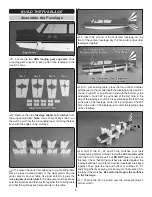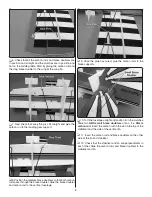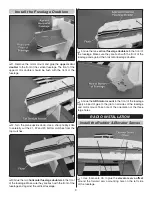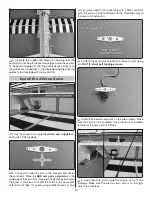
17
LITHIUM BATTERY
HANDLING AND USAGE
WARNING!!
Read the entire instruction sheet included
with your battery. Failure to follow all instructions
could cause permanent damage to the battery and its
surroundings, and cause bodily harm!
ONLY
use a LiPo approved charger.
NEVER
use
a NiCd/NiMH peak charger.
NEVER
charge in excess of 4.20V per cell.
ONLY
charge through the “charge” lead.
NEVER
charge through the “discharge” lead.
NEVER
charge at currents greater than 1C.
ALWAYS
set the charger’s output volts to match
the battery volts.
ALWAYS
charge in a fi reproof location.
NEVER
trickle charge.
NEVER
allow the battery temperature to exceed
150° F (65° C).
NEVER
disassemble or modify the pack wiring in
any way or puncture the cells.
NEVER
discharge below 2.5V per cell.
NEVER
place the battery or charger on
combustible materials or leave it unattended
during charge or discharge.
ALWAYS
KEEP OUT OF THE REACH OF
CHILDREN.
NEVER
charge the battery in the plane.
ALWAYS
remove the battery from the plane after
a crash. Set it aside in a safe location for at least
20 minutes. If the battery is damaged in the crash
it could catch fi re.
If the battery starts to swell, quickly move the battery to
a safe location, preferably outside: Place it in a bucket,
covering the battery with sand.
AMA SAFETY CODE
Read and abide by the following excerpts from the Academy
of Model Aeronautics Safety Code. For the complete Safety
Code refer to
Model Aviation
magazine, the AMA web site or
the Code that came with your AMA license.
General
1) I will not fl y my model aircraft in sanctioned events, air shows,
or model fl ying demonstrations until it has been proven to be
airworthy by having been previously, successfully fl ight tested.
2) I will not fl y my model aircraft higher than approximately
400 feet within 3 miles of an airport without notifying the
airport operator. I will give right-of-way and avoid fl ying in
the proximity of full-scale aircraft. Where necessary, an
observer shall be utilized to supervise fl ying to avoid having
models fl y in the proximity of full-scale aircraft.
3) Where established, I will abide by the safety rules for the
fl ying site I use, and I will not willfully and deliberately fl y my
models in a careless, reckless and/or dangerous manner.
5) I will not fl y my model unless it is identifi ed with my name
and address or AMA number, on or in the model. Note:
This does not apply to models while being fl own indoors.
7) I will not operate models with pyrotechnics (any device that
explodes, burns, or propels a projectile of any kind).
Radio Control
1) I will have completed a successful radio equipment ground
check before the fi rst fl ight of a new or repaired model.
2) I will not fl y my model aircraft in the presence of spectators
until I become a qualifi ed fl ier, unless assisted by an
experienced helper.
3) At all fl ying sites a straight or curved line(s) must be
established in front of which all fl ying takes place with the
other side for spectators. Only personnel involved with
fl ying the aircraft are allowed at or in the front of the fl ight
line. Intentional fl ying behind the fl ight line is prohibited.
4) I will operate my model using only radio control frequencies
currently allowed by the Federal Communications
Commission.
5)
I will not knowingly operate my model within three miles
of any pre-existing fl ying site except in accordance with
the frequency sharing agreement listed
[in the complete
AMA Safety Code].
9) Under no circumstances may a pilot or other person touch
a powered model in fl ight;
nor should any part of the
model other than the landing gear, intentionally touch
the ground, except while landing.
CHECK LIST
During the last few moments of preparation your mind
may be elsewhere anticipating the excitement of the fi rst
fl ight. Because of this, you may be more likely to overlook
certain checks and procedures that should be performed
before the model is fl own. To help avoid this, a check list
is provided to make sure these important areas are not
overlooked. Many are covered previously in the instruction
manual, so where appropriate, refer to the manual for
complete instructions. Be sure to check the items off as
they are completed (that’s why it’s called a
check list!
).
❏
1. Check the C.G. according to the
measurements provided in the manual.
❏
2. Be certain the battery and receiver are
securely mounted in the fuse with hook and
loop material.
❏
3. Confi rm that all controls operate in the correct
direction and the throws are set up according
to the manual.
❏
4. Make sure all servo arms are secured to the
servos with the screws included with your radio.




































